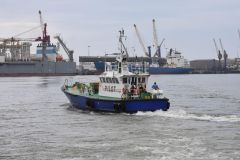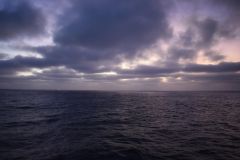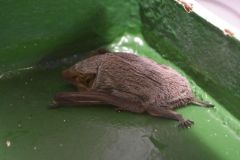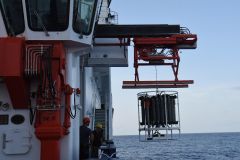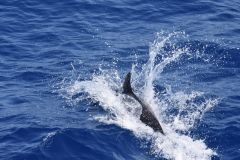
The Benguela System under climate change - Effects of Variability in physical forcing on carbon and oxygen budgets
11.02.-17.02.2022 Off to new waters
After we had to say goodbye to Jenny, Christian, Michael and Klaus in the morning, we leave 30 min later to head for Cape Verde. In the evening we discover that we have a stowaway on board. A desert bat has strayed onto the ship during the night in the harbour and is now lying on the first deck. We are able to find it for two days, then it disappears.
The scientific programme, or rather the sampling, is largely finished and almost everyone can concentrate on other work in the remaining days. As already written in the previous article, the trace gas group still has measurements to do around the clock until shortly before entering the economic zone (EEZ) of Cape Verde. We have therefore set up a watch plan for the night to support the group and to ensure that the equipment (or rather the pump) does not give up on the last few meters. Furthermore, Christian Burmeister is still in the lab to continue working through the mountain of nutrient samples that have accumulated during the trip. Without this data, almost nothing works and so everyone is very grateful to him for taking samples during almost every CTD and sediment core incubation. The oceanographers are still busy measuring and analysing their data, while the benthologists start sorting and identifying the species in their samples. At the same time, we are slowly starting to pack away the equipment that is no longer needed.
After a few days, we have another stop to make. We have reached the Angola Basin and here the last CTD goes into the water. On the one hand, physical parameters are measured and instruments calibrated, on the other hand, the last trace gas and nutrient samples are taken on board. After the CTD is safely back on deck and all the samples have been taken, there is of course a little celebration in the now tropical temperatures.
The sea here in the Angola Basin is quite calm. By now we are so far from the coast that we hardly see any animals. Not even seabirds can be spotted. One morning, however, a group of dolphins appears next to the ship. This school, consisting of 20 - 25 animals, accompanies us for a quarter of an hour until they finally lose interest in us and swim on in another direction.
Text: Fabian J., Braun P. (both IOW)
| Expedition: | MSM105 |
| Mission: | BUSUC 2 |
| Start: | 11.01.2022 - Walvis Bay |
| Ziel: | 23.03.2022 - Mindelo |
